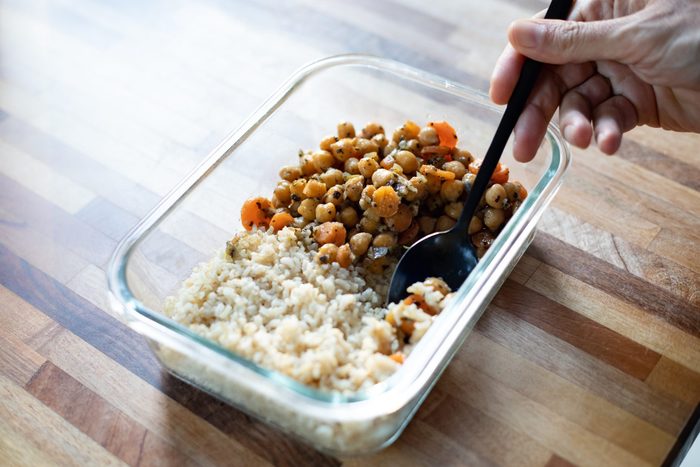Here’s How Long Leftovers Really Last

You may have some leftovers in your fridge right now that can make you sick. Here's how you can avoid food that's gone bad and how long leftovers keep in general.
Once you find a great recipe or tasty dish from a restaurant, it’s hard not to gobble it all up in one sitting. If you do happen to make or save enough for leftovers, you’re in luck. The tricky part is when you find that tin-foil-covered pizza from an undisclosed date and question if it’s safe to eat, or if it’s an expired food in your fridge.
Unfortunately, the answer to how long leftovers are good for is that it’s complicated, and it depends on a few factors, according to Donald W. Schaffner, PhD, a food science professor at Rutgers University. He recommends the same as the CDC, which is three to four days for leftovers.
Registered dietitian nutritionist Malina Malkani also recommends keeping (most) leftovers for no more than three to four days in the fridge. Note that foods that carry a higher risk of harmful bacteria include foods containing dairy, eggs, meat, poultry, fish and seafood, according to Malkani. “Lower risk foods include fruits and vegetables, bread, baked goods, preserved foods, syrups, and vinegars,” she says.
The experts explain the details on how long leftovers last, what happens if you eat old food, and how to make leftovers last as long as possible.
(Related: The Proper Way to Freeze and Thaw Food)
What about leftovers from restaurants?
Generally speaking, the answer is yes, they would have the same shelf-life as other leftovers, Schaffner says. However, foods from restaurants may be out of temperature control for longer before being placed in the fridge. Schaffner says this might affect the shelf life if those foods were out of temperature control for more than several hours. “As a general rule of thumb, we always recommend that people refrigerate their leftovers within two hours of being served,” he says.
What determines how long leftovers last?
The level of harmful bacteria and viruses in leftovers determines how long they last, according to Malkani. “When these harmful bacterias and viruses reach a level that is dangerous to health, they can cause food-borne illness causing symptoms such as upset stomach, nausea, diarrhea, vomiting, fever, and dehydration,” she says.
(Related: Can You Eat Freezer Burned Food? 5 Things to Know)
How to tell if leftovers are bad
The fastest and easiest way to tell if food has spoiled is to use your eyes and nose. “Dispose of any food that has a foul smell or signs of mold,” Malkani says. “However, keep in mind that leftovers may look, smell and even taste fine and still cause food-borne illness, so be sure to keep careful track of how many days it has been in the refrigerator and discard after three to four days.”
What’s the worst-case scenario or risk of eating bad leftovers?
“If by ‘risk’ you are talking about the risk of food poisoning, remember that if the food does not contain any pathogenic bacteria when you put it into the fridge, there won’t be any pathogenic bacteria when you take it out,” Schaffner says. “The primary risk from leftovers is spoilage, i.e. bacteria growing in the food that make it smell or taste disgusting, but won’t actually make us sick.” Plus, improperly cooking food to a safe internal temperature and leaving food out at unsafe temperatures are the main causes of food-borne illnesses.
Most common types of bacteria that cause food poisoning do not grow that well in the lower temperatures found in a refrigerator. The exception would be the pathogens Listeria monocytogenes and Yersinia enterocolitica, according to Schaffner. “So if these pathogens are not there, and your refrigerator is set at 40°F or lower, the worst-case scenario is you take the food out, you take a whiff, and it smells gross, and you want to vomit, but of course that’s not food poisoning,” he says.
(Related: 11 Mistakes Everyone Makes with Their Air Fryer)
How to make leftovers last
For best quality, refrigerate leftovers as quickly as possible. Malkani says to do so within a maximum of two hours of cooking, or within one hour of cooking if the outdoor temperature is 90° F or above. Also, make sure that your refrigerator temperature is as low as possible (40°F or less) as long as it doesn’t freeze the food. Avoid allowing foods to stay within the temperature “danger zone” of between 40° F and 140° F, which is the range of temperatures at which bacteria can more easily survive and grow, according to Malkani.
“I suggest writing dates on foods or leaving reminders for yourself on a note on the refrigerator to eat foods before a certain date,” Schaffner says. “Of course, if you don’t think you’re going to eat a food within three to four days, but you will want to eat it eventually, the best thing to do is to freeze it.”
Opting for airtight storage containers is another way to make leftovers last. And when you do eat stored leftovers, be sure to reheat to a minimum temperature of 165° F to kill potential dangerous bacteria that can cause food-borne illness, Malkani recommends.




